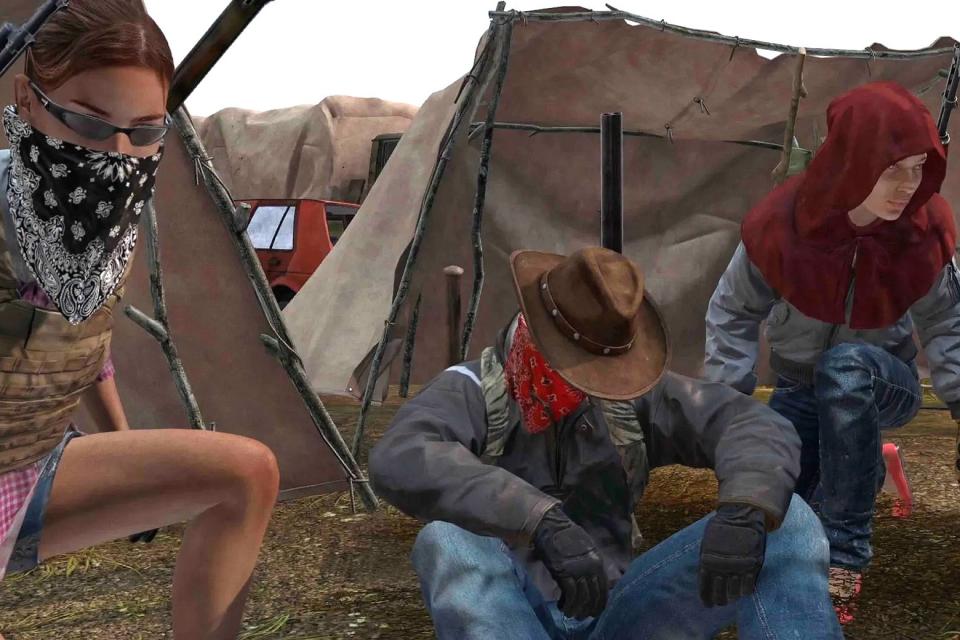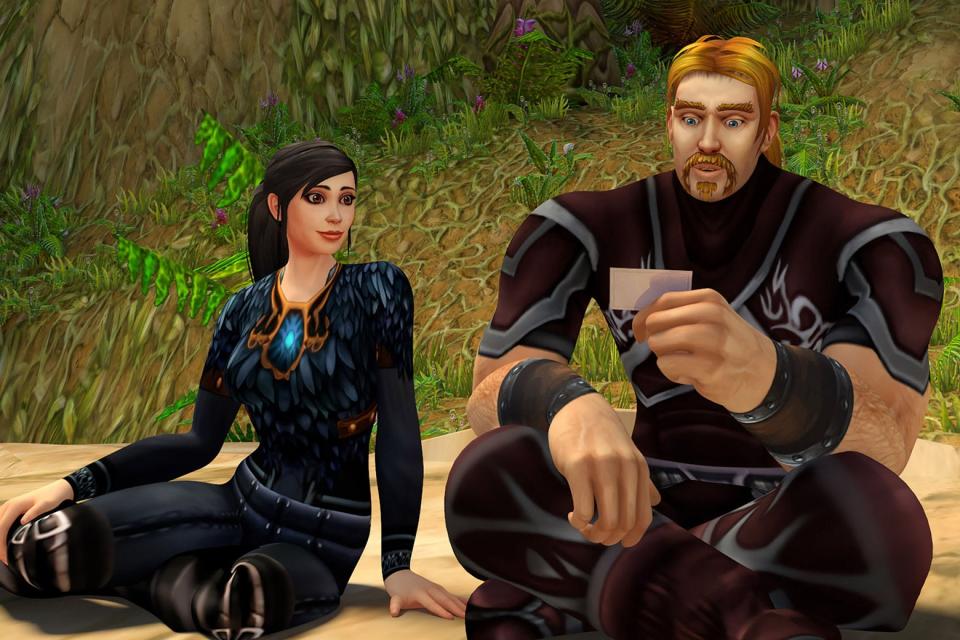A Fantastic New Movie Stages Shakespeare’s Greatest Play in a Rather Unlikely Fashion
- Oops!Something went wrong.Please try again later.
Sam Crane was in the middle of doing Macbeth when the bullets started flying. A veteran of the British stage, Crane was on the verge of playing the lead in the London production of Harry Potter and the Cursed Child when COVID-19 shut down live performances, and by the U.K.’s third lockdown, he was itching for an audience. So instead of playing to a West End crowd, he found himself orating to a smattering of heavily armed lawbreakers inside the video game Grand Theft Auto. “If I could just request that you refrain from killing each other,” he calls out amid the tomorrows and tomorrows. “And don’t kill the actors either!”
The death-defying soliloquy is part of Grand Theft Hamlet, a poignant and deeply hilarious documentary that chronicles the attempt of Crane and his friend Mark Oosterveen to stage a full-fledged Shakespeare production inside the world of Grand Theft Auto. Co-directed by Crane and his partner, Pinny Grylls, the result plays like a cross between Waiting for Guffman and a YouTube playthrough, multiplying the challenges of no-budget theater by the chaos of online interaction. Potential actors pop in and out without warning, or grow bored and simply start shooting. Not even the Globe’s audience was quite so unruly.
Grand Theft Hamlet, which premiered at SXSW this week and was acquired for distribution by Altitude Films, is part of a new wave of documentaries that take their virtual cameras inside the world of online gaming. Ignoring the games’ ostensible goals, whether it’s rising to the top of an organized crime syndicate or fending off a horde of zombies, these movies focus on the communities that form inside these virtual environments, and how, especially in a world curtailed by the pandemic, those bonds can become as complex and meaningful as any formed IRL.
One of the greatest difficulties contemporary filmmakers face is that so much of our lives take place in arenas that are all but impossible to shoot, at least in any interesting way. The art form that defined the 20th century still hasn’t found a way to catch up to the technology of the 21st. The right email or the wrong text can alter the course of your life, but a person staring at a screen looks the same whether they’re getting fired or just scrolling Instagram. How do you make cinema out of life when life has become so resolutely uncinematic?
Fiction filmmakers can simply set their stories in a world without internet, whether it’s a fantasy universe or just a remote cabin with lousy cell service. But if at least part of your brief is to capture reality, you can’t have people showing up unannounced at their friends’ front doors when they could have just sent a DM. For the makers of Grand Theft Hamlet, as well as the new documentaries Knit’s Island and Ibelin, the answer is simple: Go where the action is, even if that action takes place inside a computer.
Creating art in a space designed solely for destruction isn’t easy. After Crane and his Shakespearean collaborator Oosterveen do a sample monologue for one potential actor, the other player simply logs off, winking out of existence without so much as an exeunt. They’re thrilled to discover that another prospective player is a literary agent who already has chunks of Julius Caesar committed to memory, but it turns out that she’s only trying out her nephew’s account, and when circumstances separate them, she too is gone without a trace. “There’s probably a Venn diagram of people who play GTA and people who like Shakespeare,” Oosterveen admits, “and the crossover is very small.”
Eventually, their troupe grows, although the problems plaguing any regional theater production persist. (As out-of-town tryouts go, Los Santos is no New Haven.) Cast members take on competing obligations; locations fall through; and the police keep turning up without warning. Plus there’s the fact that GTA’s avatars only come with so many preprogrammed emotes, and existential despair is not among them. Still, the ragtag band of players finds ways to turn the environment to their advantage, like having the ghost of Hamlet’s father enter via blimp as the audience watches from the roof of a skyscraper. (Oosterveen calls it “Shakespeare on a billion-dollar budget.”)
Although Grylls adopts the onscreen look of a punked-out angel of death, she mostly stays behind the camera, letting the heads-up display in the corner of her screen serve as a mute Greek chorus. As Hamlet ponders the allure of self-destruction, the translucent panel keeps a steady tally of characters as they’re killed nearby, a deadly drumbeat that might have given even the author of Titus Andronicus pause. And when the prince of Denmark punctuates “the rest is silence” by popping a suicide pill, the display interjects, “Hamlet_thedane has chosen the easy way out.”
Grand Theft Hamlet is framed as a story of the triumph of art over adversity, about finding a way to make theater when the theater itself seemed to be facing extinction. But its more poignant subject is simple loneliness. Crane and Oosterveen were hardly the only people to stage theater online during the lockdowns. (I watched a riveting production of Heroes of the Fourth Turning performed entirely on Zoom.) But Grylls makes it clear that their production is not just a means of expressing their artistic selves. It’s also, more simply, a pretext to form connections with other, similarly isolated people. The play’s the thing, but it’s not the only thing.

In Knit’s Island, that desire to connect is right on the surface. Ekiem Barbier, Guilhem Causse, and Quentin L’Helgouac’h spent almost a thousand hours filming in the survival game DayZ, whose players are tasked with staying alive after an apocalyptic zombie outbreak. You’d hardly know that to watch the movie, though, which screens in the Museum of the Moving Image’s First Look festival this weekend. (The film is still seeking U.S. distribution.) The undead make only a fleeting appearance, and while the filmmakers still catch the occasional bullet despite their cries of “Don’t shoot, I’m a documentarist,” the game’s open-world structure leaves much more room to explore. Filming in the video game equivalent of verité style, the three—who previously directed a short documentary in Grand Theft Auto called Marlowe Drive—drift through the countryside, encountering a series of groups that have banded together according to their own priorities, forming the equivalent of miniature societies. Iris, the gleefully sociopathic leader of a gang called Dark as Midnight, welcomes the filmmakers to her stronghold by offering them a serving of human flesh, freshly sliced from the still-living man she has laid out across a desk. “All of us share one thing,” she says of her band of fellow cannibals: “We enjoy murder, and we find it very fun.” In another area, the filmmakers spend time with the Reverend Stone, whose followers worship a deity called Dagoth beneath a Russian Orthodox cross.
Unlike staging a Shakespeare play, survival is an open-ended goal, defined only by the absence of dying. The players in Knit’s Island are left to define for themselves just what survival means, a question that the privations of lockdown made all too keen. They’re staying home and staying safe, but cut off from the communities that gave their former lives much of their meaning. Do they reconstruct those relationships online, or seek out different ones, of a kind the real world might not allow them to explore? “Things that you wouldn’t do in real life become acceptable to experiment with here,” explains one player, who describes himself as an ad executive living in Africa. “You don’t really know how deep your dark side goes until you’ve dominated a few people.”
The game offers plenty of ways for players to explore their dark sides. But many embrace the ability to just do nothing. The ad exec isn’t speaking to the filmmakers while holding another player at gunpoint but in the midst of a vast, deserted underground cavern that he calls “this sort of calm and peaceful world.” He admits that, in real life, he’s sitting only a hundred meters from honest-to-god nature, but he chooses to immerse himself in its virtual analogue instead. (I get it: I spent untold hours during the pandemic savoring the whoosh of wind through grass in The Legend of Zelda: Breath of the Wild, rather than going outside and literally touching it.) The Reverend, noting the lulling crackle of a nearby campfire, calls this “the most relaxing game I have ever played.” Still, he admits, “at any time we could be shot.”

Slugmite, an Australian who once worked as a koala tracker, enjoys exploring the game’s “fake wilderness” with her husband, who goes by Macro. (The filmmakers ask for their real names; Slug and Macro decline.) They play together, but from different places in their home, and while they might be fans of slaughtering zombies, the movie mostly shows them savoring quiet moments, or conspiring to break the boundaries of the game. They show the filmmakers how, by pressing their avatars’ bodies up against the edge of the rock, they can enter what they call the “underworld,” passing through a glitchy horizon to float in what looks like an endless pool of soft, white light. Eventually, we join a massive group who spend hours of in-game time just running in a straight line, in an apparent attempt to see if their virtual environment ever just ends.
In Ibelin, a Netflix documentary that premiered at Sundance in January, a Norwegian gamer with progressive muscular dystrophy builds a new life inside World of Warcraft, where his burly avatar solves mysteries, makes friends, and even falls in love. Director Benjamin Ree wasn’t able to capture Mats Steen, who died in 2014, inside the world where he spent 20,000 hours over the course of his last 10 years, but he used a vast archive of in-game interactions as the basis for a string of reenactments animated with game graphics. That approach loses some of the particular flavor of online communication—you don’t have the disconcerting experience of realizing the operator of the blank-eyed avatar you’re talking to has unexpectedly gone AFK—but stepping outside the game allows Ibelin to take stock of just how much Steen’s time inside it meant. Steen didn’t tell his family about his life online, and he didn’t tell the people in his gaming community who he really was, so the two worlds only intersected after his death, when his parents found the blog he’d used to chronicle his adventures. It was only then they learned that the young man who was all but immobilized in his bedroom had lived a richer existence than they ever imagined. The computer, he wrote, “is not a screen, it’s a gateway to wherever your heart desires.”

